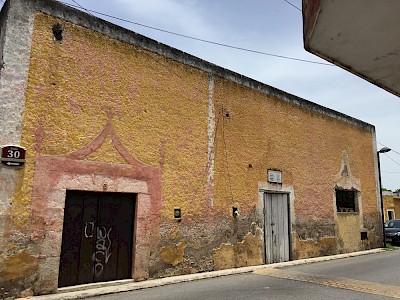Rebuilding History - Casa Kinich
An Architectural Adventure
In January 2000, my son grown and ready to graduate college, I left my home of twenty seven years, packed up my real estate business in San Antonio and moved to the Yucatan, long a love of mine. After a short stint running a bamboo plantation near Uxmal, I realized I was never cut out to make a good employee and, seeing a big need, started my own real estate company, Tierra Yucatan, in Merida.
I have always loved old, historic properties and it was very easy to get excited about the lovely architecture of Merida’s Historic Center. History is everywhere here, layer upon layer, modern upon Spanish; colonial upon pre-columbian Maya remains.
Although my business is in Merida, about twelve years ago I moved to a small village about 45 miles east, just 8 miles north of Izamal...I am in love with the peace and rural quiet of life outside Merida and the four days I spend in the city is plenty.
Now it is mid-2018 and I’m chewing my fingernails and studying my bank accounts about to plunge headfirst into a new project...the remodeling and construction to transform a very, very old “ruin” in lovely Izamal. It is exciting and nerve-wracking and I thought you might like to look over my shoulder and share the adventure.
Izamal
Izamal is an enchanting, colonial city built on top of a pre-Columbian Maya ceremonial center. Pyramids too large for the Spaniards to demolish are at the center of every downtown block, even after providing the construction material for most of the old center. At the heart of Izamal, built over the remains of the largest pyramid, sits an enormous convent finished in 1561 and still an important center of pilgrimage. The atrium is second in size only to the Vatican and, in 1993, Pope John Paul celebrated mass here. In his honor, the town was painted golden Vatican yellow, a color it famously maintains to this day. The town is dotted with huge pyramids and full of beautiful colonial houses–some in ruins–all painted with the same deep yellow ochre.
The street plan of the town still follows the ancient Maya, pre-Columbian footprint and horse drawn carriages still ply the streets, giving the many tourists a leisurely trip. When I first moved from Merida, these were the only taxis and trotted gaily through town bearing huipil-clad local ladies to the market.
Running Tierra Yucatan keeps me busy in Merida most of the week and I always seem to have projects underway. On Wednesdays and week-ends I am in and out of Izamal on various errands or to see friends; it has some good restaurants and several supermarkets and is so pretty it does me good to just drive around and enjoy. On one of these rambles, Casa Kinich “just happened.” I have always noticed it sticking out into the road with its curious old “nicho” or alcove, built into the wall; run down and derelict, the façade no longer beautiful after windows were blocked and door sizes reduced. It sits very close to the convent–just a five minute walk–and is one block from the largest remaining pyramid: Kinich Kak’Mo (Temple of the Fire Macaw in Maya). Stones from that pyramid were used in the construction of this original colonial home. Seeing a hand scrawled ‘For Sale’ sign, I called, mainly out of curiosity, and before I knew it, I had committed myself to become the new owner.
The House Today
Really, the house “as is” is hard to love. One very large old room with eighteen foot beamed ceilings, now several feet below street level as time and repaving have gradually pushed the road higher and higher. The “nicho” which once held the household saints is at ground-level outside, but several feet from the floor inside. Tacked on is a crude, block construction, room and a tiny, primitive bathroom, which will be demolished.
After letting it sit for more than a year, uncertain whether to invest money in the restoration, I am now mustering the courage to start creating a beautiful two bedroom home with rooftop views of the Convent to the south and Pyramid Kinich to the east.
Follow me, here we go!
Installments for the house (and articles about its progress) won’t be on any particular schedule. I have chosen my architect, have preliminary plans, and am about to make the first down-payment. At this stage we are still working with INAH, Mexico’s institute governing historic sites and buildings, to finalize permits. As the house sits on what was once part of the Maya ceremonial center, an archaeologist will be on-site as we dig foundations and prepare for a pool – who knows what lies underneath! I can’t wait to get started and share the story with you here!












